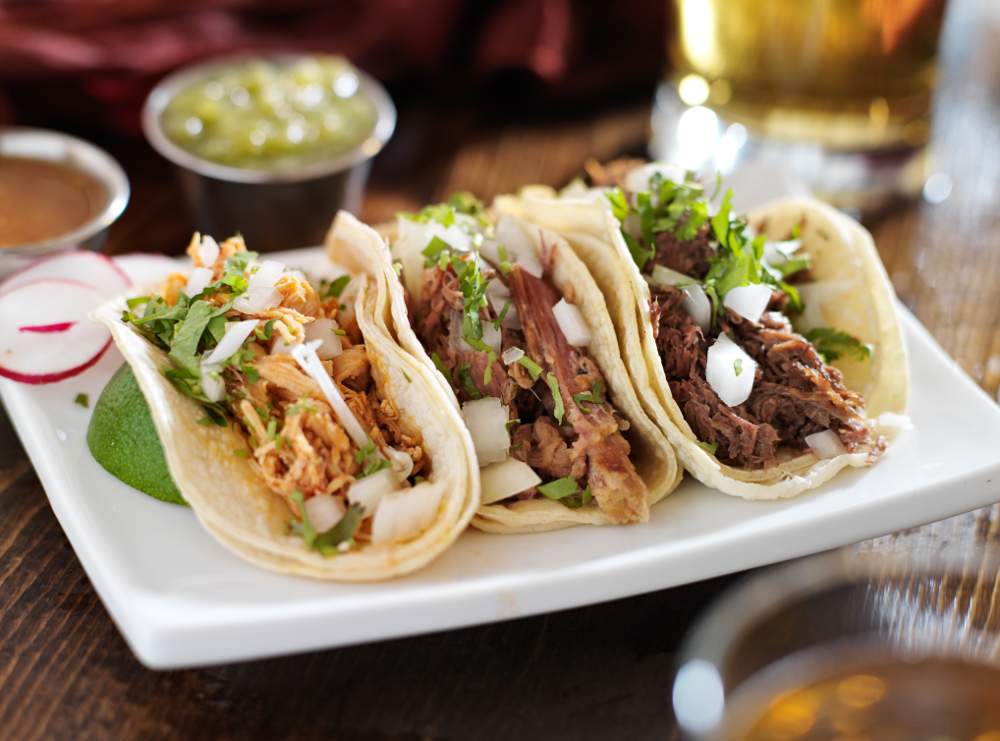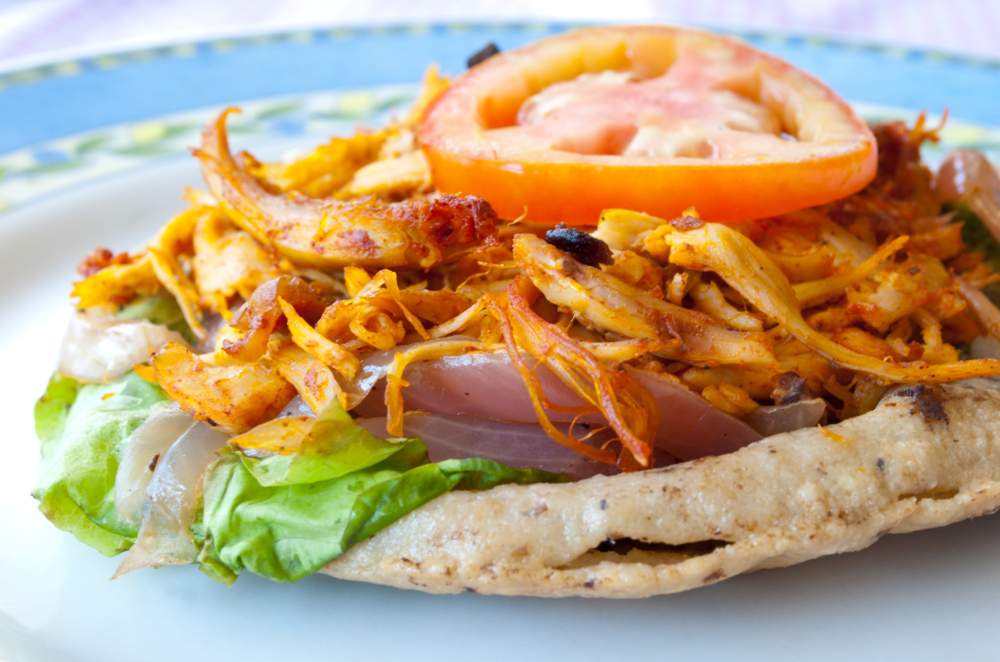In 2011 I took my first trip to Mexico to taste the dishes I’d fallen in love with. I disembarked and rushed to the first restaurant I could find. I stared at the menu. For several minutes. I didn’t understand. Where was the chili con carne, the nachos, the burritos, the chimichangas or the sizzling skillet of fajitas in my choice of chicken, beef, or both? I turned the menu over, shook it out, expecting another page to fall loose. It didn’t. I spoke to the waiter. And that was when I discovered the truth.
I’d been besotted with Tex-Mex, a cuisine that derived not from Mexico, but a completely different country in the US-Mexican border state of Texas. A food type that took some influence from Mexico but that was entirely made in the USA. My heart sank. I’d flown all that way for…what did the waiter recommend…chila-something? I was contemplating my options, a small part of me wondering how much it would cost to re-route my ticket to Texas, when my dish arrived. It looked like no “Mexican” dish I’d ever eat before, but politeness prevailed, and I put a forkful in my mouth. Hmm, it actually tasted good. Another forkful. No, it tasted amazing. In fact, better than any Tex-Mex I’d ever tasted. As quick as that I was smitten. I had found a new love – real Mexican food – and I intended to get to know it better.
With months spent in Mexico and the assistance of a fellow food-loving Mexican friend I have sniffed, tasted, explored, and inquired about the ingredients of as many Mexican dishes as my appetite has permitted me to get my teeth into, and a few more besides. For anyone intending to take their taste buds to Mexico, here’s a guide to Mexican food for those seeking something a little more authentic.
The basics
I was fortunate that the first restaurant I stumbled into served traditional food as Tex-Mex can, in fact, be found in many areas of Mexico. Where tourists linger, it is possible to find gigantic granite bowls of guacamole and chips, and I’ve seen more than one of the sizzling fajita skillets that I was initially searching for.
That’s not to saying that the Tex-Mex food in Mexico can’t taste great – the nachos with luminescent orange melted “cheese” sold on the streets of Guadalajara are a raging hit with tourists and locals alike, but there is a reason UNESCO have pinned the tag “intangible cultural heritage” on Mexican cuisine. It has grown up over centuries, with farming, blending, and cooking skills combining to make Mexican food the wonder that it is. Ordering a dish that has a foundation of a family recipe passed through the generations is guaranteed to present a dish on your plate that is almost always going to be superior to any food cooked from a Tex-Mex cookbook delivered courtesy of Amazon.
The same goes for margaritas. Taking the basic premise of the Mexican tradition of sipping tequila with lime and salt and adding the twist of ice to make it more drinkable for non-Mexican palates, the margarita was born. It can be found in every fruit flavored blend, straight up, over ice or frozen, but never authentic and always missing the point – to be in Mexico should be to taste Mexico, and yes, that means ditching the sickly sweet syrups in favor of doing it like the locals, even if the thought of tequila does make you wince.
The staples

It didn’t take many meals to realize that there were some basic ingredients that found their way onto my plate with every meal: corn tortillas, beans, chili, and lime. Check for their presence and you have a pretty reliable indicator of the authenticity of the food.
Corn is the undeniable King of Mexican cuisine and is used as the basis for the ubiquitous tortillas (circular flat breads, not to be confused with tortilla chips) that are served with every dish regardless of how many carbohydrates have already been provided. Meanwhile, beans are equally competent at finding themselves a role in your meal, even if only as a side dish.
Flavor is thankfully high on Mexico’s menu, with cilantro and onions used particularly heavily, but the two most common additions are chili and lime. From jalapeno to habanero and chipotle to poblano, it would be possible to write an entire article on Mexico’s chilies. Suffice to say they can be fiery (habanero in particular) and will be present somewhere, whether in the dish or innocent looking salsas, so if your heat tolerance is low, don’t forget to ask if it is picante!
“Limon” is also omnipresent. Don’t let the names confuse too much. Limon refers to the small green fruit known in many countries as lime and not the larger yellow citrus fruit that is called lemon in many other places. Regardless of the name, it won’t take long before you find yourself fretting on the rare occasion the bowl of limon is absent.
What to eat

Like most countries, Mexican food has many regional variations, and even dishes like tacos, that can be found everywhere, can differ wildly from one place to the next. However, without exploring these differences in too much detail, here are some of the most traditional dishes to sample in Mexico.
Breakfast
Breakfast in Mexico often comprises eggs (huevos), but setting the theme for the rest of the day, tortillas, beans, and salsa will almost certainly be present, too.
Eggs tend to come revuelto (scrambled) or frito (fried), but it is the extra ingredients that make Mexican breakfasts so delicious.
- Huevos a la Mexicana is so called because it contains the colors of the Mexican flag: white onion, red tomato, and green hot pepper added to scrambled eggs. Usually served with more tortillas than you’ll ever humanly needs as well as refried beans, huevos a la Mexicana is a good, cheap, simple, and filling way to start the day.
- Huevos rancheros have a fried tortilla base covered with a fried egg and tomato salsa, and is usually accompanied by refried beans, avocado, or guacamole. The dish is reputedly named after the dish served mid-morning on rural farms.
- Huevos divorciados are literally divorced, two fried eggs are served separated by a wall of refried beans. One half is covered in red salsa, the other in green, and tortilla chips are often spiked into the beans.
- Chilaquiles is my personal favorite. The traditional form involves corn tortillas cut into quarters and lightly fried before being added to red (or green) salsa. Often served with fried or scrambled eggs and topped with queso fresca (white shredded cheese), crema (sweet Mexican cream), and raw white onion rings, the dish is substantive. Replace the eggs with shredded chicken, and chilaquiles becomes a good meal to have at any time of the day.
- Tamales are also a popular breakfast dish as well as all day snack. Served sweet or savory, tamales are typically made from masa (corn based dough) that is wrapped in a leaf and steamed. Tamales are filled with meat such as pork or chicken cooked in red or green salsa or mole (see below). Raisins, dried fruit or sugar are added to make sweet tamales. Small but filling, tamales are a delicious comfort food.
Antojitos – snacks and street food

Antojitos are a firm friend of the budget traveler. These street food snacks can be ordered individually and grazed on until you are full, making them perfectly versatile for filling a small gap or providing a larger meal. Some of the most common types of antojitos include:
- Quesadillas (or quekas) comprise a large tortilla filled with meats or vegetables. Cheese is always added before the tortilla is folded and cooked. Try chicharron (pork rind), tinga de pollo (chicken in tomato chipotle sauce), champiñones (mushrooms) or go for a simple version with cheese or refried beans.
- Sopes, huaraches, and tlayudes are made from the same dough as tamales. Sopes are topped with refried beans, lettuce, onion, salsa (red or green), cheese, and often meats. Sopes are generally small, about the size of a fist. Huaraches are typically made in the same way as sopes but are bigger and oblong-shaped, while tlayudas are very similar in style, too but use a very large fried tortilla as a base. Tlayudas are generally native to Oaxaca and can be ordered topped with chapulines (fried grasshopper).
- Tortas – Buy a sandwich at a bus station and you’ll fast realize there are several versions of jamon y queso (ham and cheese) but little else. If you want a better range of fillings, then you need to seek out tortas, which usually comprise an oblong white roll filled with meats (chicken and pork) and vegetables (cabbage, avocado, tomato, lettuce). Torta Ahogada is certainly worth searching for. Literally meaning drowned sandwich, the torta is filled with pork and covered in a chili tomato sauce and topped with avocado, onion and radish. Probably not one to be packed for a bus ride, though.
- Tacos – Almost deserving a section in their own right, tacos are one of the most popular, universally available, and delicious foods available in Mexico. Forget the Tex-Mex version with the hard shells stuffed with chili con carne and instead imagine small, soft tortillas a little bigger than your palm, filled with meat (chicken, pork, beef, and chorizo are most common) or fish and garnished with chopped onion, cilantro, lime, salsa or guacamole. The fillings and garnish will vary from one taco stall to the next, but what rarely differs is the amazing taste that will have you addicted to tacos in under a week. Try them “al pastor,” which uses meat cooked in the same way as kebabs on a large spinning skewer.
Other dishes
- Enchiladas – Yes, enchiladas are served up in many a Tex-Mex restaurant, but Mexican enchiladas are a little different. Instead of the chicken, onion, and pepper wrapped tortillas that are smothered in gooey melted cheese, Mexican enchiladas are usually much simpler with a chicken filling covered in red or green salsa or mole (see below) and dressed with the same creama, queso fresca, and raw white onion rings added to other dishes.
- Birria is a broth-based soup made from goat or sheep meat and is often served with the staples – tortilla, cilantro, onion, and lime. It is said to be good for a hangover, which is an interesting thought since it is native the state of Jalisco, home to the town of Tequila.
- Pozole is another traditional soup, this one made with pork, homily (the white corn that is popular in Mexico), and chili. The soup is generally thicker than broth and is garnished with lettuce, onion, cilantro, and lime.
- Mole – Admittedly, mole is a sauce rather than a dish in its own right but it deserves a special mention. Popular at celebrations including weddings, birthdays, and traditional Christmases, mole is a complex blend of around 20 ingredients or more including chili, cumin, garlic, tomato, anise, nuts, and clove. It comes in a rainbow of colors from black (mole negro) to green, red, and yellow and is particularly native to the central and south, with Oaxaca and Puebla mole’s being most famous. Perhaps the most unusual ingredient for non-Mexican diners is the addition of chocolate. Added at the end of cooking, some moles such as mole poblano are sweetened in this way. While it may take some time to acquire the taste, once you do, you’re unlikely to look back. Mole can be served in many ways, including over chicken and rice, with enchiladas, or inside tamales.
Sweet stuff

Eat even a slice of white bread in Mexico and you’ll realize the country has an incredibly sweet tooth. However, the range of desserts is not as broad as you might expect, mostly because the main meal is so substantive, there is rarely space for much else.
If you are craving something sweet, helado (ice cream) is always popular and readily available, otherwise try:
- Flan – Omnipresent, flan is similar to crème caramel – comprised of set custard topped with a soft layer of caramel.
- Arroz con leche – Otherwise known as rice pudding, this milk-based dessert is another popular choice that can be found easily and is usually sprinkled with cinnamon.
- Churros – The scent in the street will lure you in as the doughnut-esque batter fries in bubbling oil. Churros are long and thin and are sometimes stuffed with cajeta (caramelized condensed milk) or can be dipped in melted chocolate. They won’t win any health awards, but based on the taste, you’re unlikely to care.
- Spicy fruit – The range of fresh fruits in Mexico is impressive from mango to pineapple to papaya. The most popular way to eat it is from street stalls, doused in lime, squirted with tomato salsa and sprinkled with chilli powder. Sounds weird? Maybe, but try it, you’ll be surprised.
What to drink
The Mexican drinks menu is nice and simple. Of course international brands like Coke can be found everywhere, but when it comes to the native flavors, there are few things you need to know.
- Aguas frescas are one of the most popular types of soft drinks. Made from steeping fruit, seeds, and cereals in large vats of water, these drinks are available on nearly every plaza corner. Don’t be intimidated by the vivid colors, lack of signage, and thick sediment at the bottom of the glass bottles (its just the fruit or seeds). Point and order – I’ve yet to find one I don’t like. Particularly popular are Jamaica (pronounced hamica), which is made from hibiscus and tastes a little like cranberry juice, and my personal favorite, horchata, made from rice with a hint of cinnamon. Tuna is also worth a try – tuna being a fruit, not the fish.
- Coffee – What can I say? Mexico is one of the world’s largest coffee producers and consequently has some excellent Arabica. Found particularly in the south in Chiapas and close to the Guatemalan border, if you can find it local and fresh, drink it until you can drink it no more.
- Cerveza and michelada – Beer is perhaps the most popular alcoholic drink in Mexico. There is a bit of a duopoly when it comes to brands with Grupo Modelo and FEMSA fighting it out for the top spot with internationally familiar Corona and Sol brands respectively. Modelo is my personal favorite, but other brands to try include Indio, Victoria, Pacifico, Tecate, and Montejo. Most cevezas are the pilsner style.
For a Mexican twist, try michelada, cerveza served with lime, chili, Worcestershire sauce, clamato (tomato juice) and a salted/spicy rim. Not everyone is a fan, so you may want to taste someone else’s before fighting your way thought a whole one.
Tequila and Mezcal
We all know the saying – one tequila, two tequila, three tequila, floor, and you’ll probably want to keep this in mind if you decide to sample the local brew. Alcohol content ranges from 35-55% but tends to linger around 40%. So, what’s the deal – do you sip it, shoot it, search for the worm?
Local advice seems to be this: first, check the quality of the tequila, making sure you have 100% agave rather than an agave and sugar mix. Next, there are different ages to consider. Blanco or plato (white or silver) are generally un-aged and are best drunk quickly, preceded by a lick of salt and followed by a bite of lime. After that there is reposado, “rested” for 2 months to 1 year, añejo (1-3 years), and extra añejo, aged for more than 3 years. In short, the older the tequila, the better and smoother it tastes. Reposado and añejo should be capable of being sipped, often with a lime wedge dipped in salt to taste between sips.
Mezcal is a similar to tequila but is made from maguey, a different plant but also from the agave family. Many locals prefer mezcal to tequila, but I’ve still to acquire that preference.
As for the worm, it is never found in tequila, only mezcal, and even then it is only ever present as a marketing ploy. So if there’s a worm in your tequila, you should probably search out something a little more authentic.
Mexican food is one of the most varied in the world, and the above list could continue on for much longer. Whether you use it as a handy eating guide for your first trip to Mexico, add to it, detract from it, or use it cook some traditional food at home, let me know your personal favorites, even if they’re missing from the list above, and whatever you do, try to avoid the fajitas and margaritas.
Check out the following articles and resources to plan your trip to Mexico:
- Find a flight to Mexico
- Check out hostels in Mexico
- Read How to Plan a Trip in Central America
- Read A Guide to Visiting Maya Ruins in Central America (Get There While You Still Can!)
- Read Why You Should Ignore All the Urban Legends & Take The Kids to Mexico
- Read The Mexican Coast You Didn’t Expect: Four Reasons to Visit Mazatlan
- Check out our Mexico City Indie Travel Guide
With thanks to Martha Hernandez for accompanying me on many any eating adventures, even when our stomachs were full, for explaining which foods were traditionally Mexican and, most importantly, for teaching me the art of sipping tequila.
Photos by: dream79, Javier Correa, Joshua Resnick, nito, Joshua Resnick, chrupka
